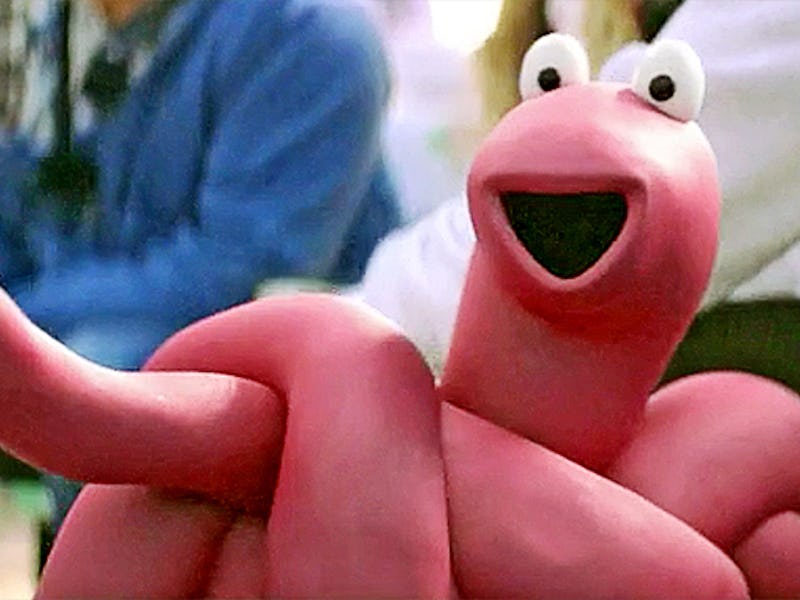Prescription Medication Mascots Are the Unsung Heroes of Cable TV
The Zoloft egg, the Belsomra cats and dogs, the Xifaxan diarrhea dinosaur, and other intriguingly strange brand mascots.

I recently moved into an apartment with cable TV, something that had been consistently missing from my life for the past four years. With so many streaming services and original programming available, watching live TV reserves few benefits. And commercials are arguably the worst part — why wait through these mind-numbingly boring breaks in programming? I recently came across a surprising answer to that question: to experience the delightfully weird world of animated mascots on prescription medication commercials.
Cable TV loves to run advertisements for prescription medication, and it’s something that’s been happening for a long time. Vividly-colored footage of a heterosexual couple in their late 50s doing extraordinarily normal things like going to the grocery store or taking a walk is common viewing material during these advertisements. The narrator of the advertisement probably rolls through an extensive laundry list of horrifying side-effects — internal bleeding and death are almost always included. Sometimes, though, these advertisements opt for an exceedingly strange animated figure to tell the story, rather than real people. We’ve rounded up the weirdest and most iconic animated mascots for prescription medication commercials, the true unsung heroes of cable TV.
The Zoloft egg
The depressed egg in the Zoloft commercials is one of the most widely-recognized spokesmen of prescription medication. It does a great job at advertising the medication, too — this egg is so ostensibly depressed (before going on Zoloft, of course) that it actually makes an impact. I do not believe you if this tiny, lonely egg doesn’t make you feel some type of way. I’m not sure if this innocent object is even supposed to be an egg, but what matters is that a bright sun replaces the looming dark cloud that followed him around before taking Zoloft.
The Xifaxan diarrhea dinosaur
To brighten up the mood following the ever-depressing Zoloft egg, let’s move on to the jubilant animated mascot for Xifaxan, a medication for irritable bowel syndrome. Perma-diarrhea is no fun, but the Xifaxan diarrhea dinosaur is here to tell you that it gets better. The mascot looks like a friendly dinosaur made out of pink Play-Doh except its midsection is a robust tangle of intestines made to look like a human’s innards. A condition as unpleasant and intrusive at IBS deserves a brand figure that can inspire some optimism in its potential customers. The spritely Xifaxan diarrhea dinosaur wants you to know there is a medication that can make your “B” a little less “I.”
The Lunesta butterfly
Lunesta, an anti-insomnia medication, sends a message of tranquility and sleepiness by way of an iridescent butterfly that stops from house to house giving insomniacs the sweet relief of sleep. You have to wonder — what is the connection between sleeping and glowing butterflies? I can think of plenty more relaxing, sleep-inducing scenarios than waiting for an unidentified glowing insect to fly into my room and send me to sleep.
The Belsomra “cats and dogs”
Continuing with anti-insomnia medications, TV commercials for Belsomra are common since the FDA officially approved the medication last year. I guess the newer the medication the stranger the face of the brand because the Belsomra “cats and dogs” are exceptionally confusing and peculiar to the point of being rather disturbing. In the commercial, the “cats and dogs” are not live animals but rather the words “SLEEP” and “WAKE” spelled out in furry letters prancing around and cuddling up to their owner the way a cat or a dog would. There are close-up moments in the commercial — for example, when the viewer can see the individual hairs of the animal’s coat — that demonstrate the effort that went into creating these fluffy, anthropomorphized words. At times, they do look like live animals because their movements are fluid and closely mirror the way a cat or dog would move. After watching the commercial, you’ll probably be thinking, “What the hell?” Unfortunately, I don’t have an answer.
Pristiq’s wind-up toys
The chosen mascot for Pristiq, a prescription medication used to treat major depressive disorder in adults, actually makes some sense. In the commercial, the narrator compares her struggles with depression throughout the day to a wind-up toy that keeps losing steam. The point is depression makes even the most ordinary tasks feel like burdensome chores, and this is communicated rather clearly through the wind-up toy. That doesn’t mean it’s not the creepiest looking wind-up toy I’ve ever seen. Pristiq wind-up toys get you through your depression — batteries sold separately.
The Nasonex Bee
What if bees were allergic to flowers, like humans? That would make pollinating them unusually difficult. Nasonex commercials explore what happens when a Latino bee with a sexy accent finds himself in this tricky situation. Luckily, Nasonex nose spray clears his sinuses and allows him to breathe in all the pollen he wants, all day long. May the Nasonex bee breathe clearly for the rest of his days.